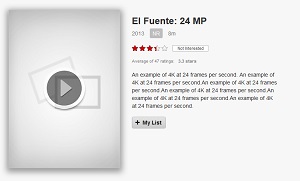Netflix Begins 4K Streaming Tests

Netflix has begun to test 4K streaming ahead of an anticipated rollout sometime next year.
As first reported by GigaOm last week, Netflix has posted a batch of 4K HD titles recently, including one called El Fuente: 24 MP, described as “[a]n example of 4K at 24 frames per second” that appears to be footage for internal testing, rather than part of a bona fide 4K/Ultra HD offering. At last check, one of those posts already had 47 ratings.
Netflix plans to launch 4K services "sometime next year," a spokesman said.

That follows comments made by Netflix CEO Reed Hastings last month when the company, which has 29.93 million paid domestic subscribers, reported third quarter results. “We want to be one of the big suppliers of 4K content next year,” he said at the time.
In September, Hastings shed more light on those plans in September during a video interview with the producer of the Copenhagen Future of TV Conference, noting that he expects 4K video to initially take hold on tablets, laptops and PCs while the costs for 4K-capable televisions drop. Hastings also said that Netflix subs will likely need about 15 Mbps to stream 4K. “If you’ve got a 50-megabit connection you’ll be fine," he said.
Netflix currently offers a library of "Super HD" 1080p content to all customers, even those whose ISPs have yet to join Open Connect, Netflix's private content delivery network that relies on private edge caches.
Although traditional pay-TV operators are expected to launch 4K services of their own, over-the-top distribution is expected to make up the bulk of first movers.
The smarter way to stay on top of the multichannel video marketplace. Sign up below.
Sony, for example, has recently launched 4K video download service that uses files that are 45 gigabytes to 60 gigabytes in size. Odemax, meanwhile, has begun to test a 4K download service that offers dozens of independent films and works in tandem with the Red Digital Cinema’s 4K-friendly, high-capacity Redray Player, which can also support widely used 1080p and 720p TVs.
Among U.S. cable operators, Comcast has not announced plans to launch a 4K service, but the operator demonstrated 4K at The Cable Show in June, delivering content in the eye-popping format over a DOCSIS 3.0 50 Mbps IP connection as well as via the MSO’s QAM video infrastructure using H.265/High Efficiency Video Coding, a compression scheme that is about 50% more efficient than H.264/MPEG-4.
